Consultation Paper on Inchoate Offences - Law Reform Commission
Consultation Paper on Inchoate Offences - Law Reform Commission
Consultation Paper on Inchoate Offences - Law Reform Commission
You also want an ePaper? Increase the reach of your titles
YUMPU automatically turns print PDFs into web optimized ePapers that Google loves.
proximately c<strong>on</strong>nected with the intended offence, whether or not there wasany act unequivocally showing the intent to commit that offence”. 502.39 The English Court of Appeal‟s judgment in Davey v Lee 51 hasbeen seen as endorsing the unequivocal act approach. 52 A translati<strong>on</strong> of theItalian Penal Code provisi<strong>on</strong> <strong>on</strong> attempt reads “Any<strong>on</strong>e who does acts aptlydirected in an unequivocal manner towards commissi<strong>on</strong> of a crime shall beliable for an attempted crime…” 53 In United States v Oviedo 54 it was saidthat the act must corroborate the mens rea:“[W]e demand that in order for a defendant to be guilty of acriminal attempt, the objective acts performed, without anyreliance <strong>on</strong> the accompanying mens rea, mark the defendant‟sc<strong>on</strong>duct as criminal in nature. The acts should be unique ratherthan so comm<strong>on</strong>place that they are engaged in by pers<strong>on</strong>s not inviolati<strong>on</strong> of the law.”The reas<strong>on</strong> for this was evidential, that is, to prevent c<strong>on</strong>victi<strong>on</strong> of theinnocent <strong>on</strong> the basis of inferences from possibly unreliable testim<strong>on</strong>y andthe history of the defendant.(I)Evaluati<strong>on</strong> of the unequivocal act approach2.40 McAuley and McCutche<strong>on</strong> identify the chief weakness of theunequivocality approach as its likelihood of leading to unmeritoriousacquittals. 55 The c<strong>on</strong>cern is that <strong>on</strong> a charge of attempting a specific offencethe defendant will escape liability if it can be dem<strong>on</strong>strated that his acti<strong>on</strong>swere capable of being viewed as trying to achieve something other than thetarget offence specified in the indictment. Glanville Williams illustrated thispoint with the example of the man found kneeling beside a corn stack withpipe in mouth and matches in hand. 56 Even with independent evidence ofintent to burn the corn this man evades attempt liability since his act isequivocal: it is ambiguous between trying to set fire to the corn and trying tolight his pipe. This is how the pure unequivocality approach as developed50515253545556Secti<strong>on</strong> 72(3) of the Crimes Act 1961 (NZ). Emphasis added.[1967] 2 All ER 423.McAuley and McCutche<strong>on</strong> Criminal Liability (Round Hall Press 2000) at 418-419,Gord<strong>on</strong> Criminal <strong>Law</strong> (3 rd ed Green & S<strong>on</strong>s 2000) at 195.Translati<strong>on</strong> of Article 56 of Italian Penal Code from Rocco, Maitlin and Wise, TheItalian Penal Code (Sweet and Maxwell 1978) at 18.525 F.2d 881 (5 th Cir.1976).McAuley and McCutche<strong>on</strong> Criminal Liability (Round Hall Press 2000) at 421.Duff discusses this example: Duff Criminal Attempts (Oxford University Press 1996)at 51. See also Dressler Cases and Materials <strong>on</strong> Criminal <strong>Law</strong> (3rd Ed Thoms<strong>on</strong>West 2003) at 762.33
















